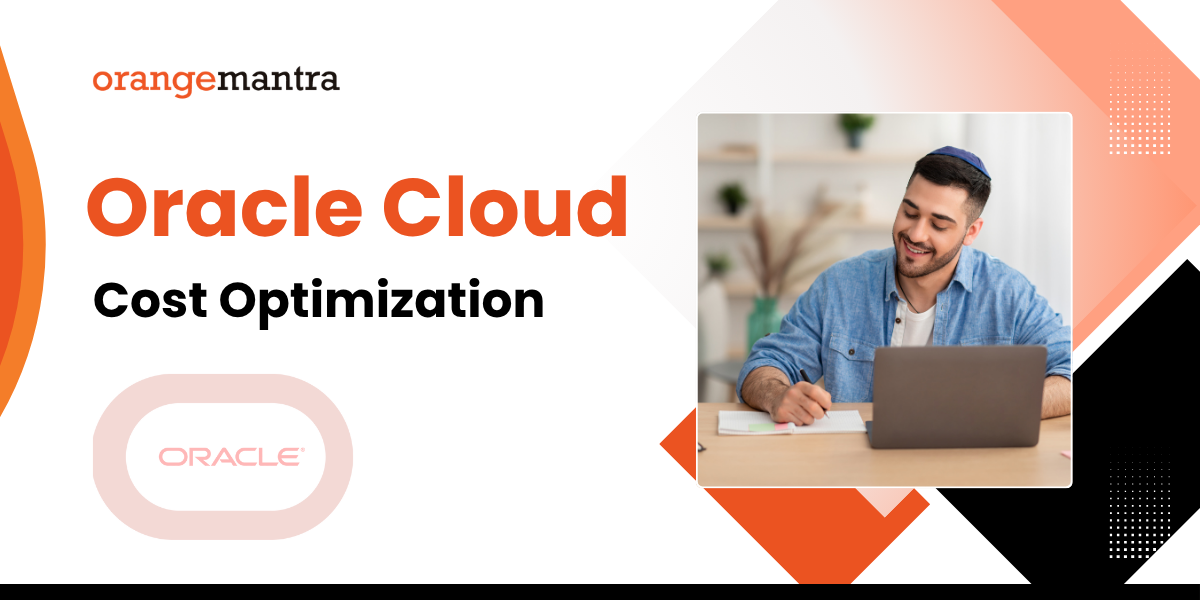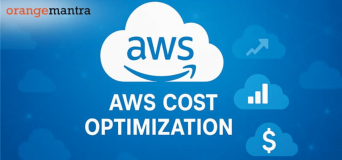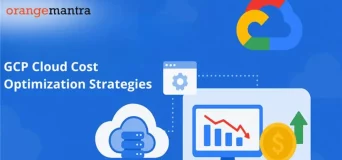
Here’s what you will learn:
Do you know the existing market realities and why cost optimization of Oracle is important in the year 2026?
Well, let me give you an overall picture of what market scenarios will be in upcoming years.
According to Reuters’ latest reports, Oracle is projecting Oracle Cloud Infrastructure (OCI) revenue to grow by about 77% in fiscal year 2026, reaching US$18 billion. Along with that, there’s a massive backlog in remaining performance obligations (RPO)—e.g., a $455 billion RPO cited in some recent quarters.
A Statista report further highlights that global cloud cost optimization remains a top priority, with 69% of enterprises actively investing in optimization strategies in 2025.
This guide will give you a comprehensive idea about the cost optimization of Oracle Cloud platforms. So, let’s get started with an overall understanding of Oracle cloud cost optimization strategies, benefits, and best practices.
As organizations continue to accelerate digital transformation, cloud infrastructure has become the beating heart of their business operations. However, along with scalability and innovation comes a growing concern—cloud overspending. That’s actually why I’m writing this fourth blog in my cloud cost optimization series. Earlier, I covered GCP cost optimization, Azure cost optimization, and AWS cost optimization — and now it’s time to explore Oracle Cloud cost optimization, which plays a crucial role in achieving long-term cloud efficiency.
Provided that your business uses Oracle Cloud Infrastructure (OCI), you have probably been watching the monthly bill slowly increase. The solution? An organized and tactical plan towards Oracle Cost Optimization.
Table of Contents
Development of Oracle Cloud cost optimization?
Let’s start with the basics.
Oracle Cost Optimization is the art of analyzing, controlling, and optimizing the expenditure of running workloads on the Oracle Cloud Infrastructure (OCI). It is not only about reducing costs but also ensuring that all the money spent on the cloud generates business results.
Imagine it was a powerful engine; you are not decelerating it, you are just making it operate smoothly, faster, and more efficiently. Oracle Cost Optimization is the ability to optimize resources through the use of automation and the Oracle Cloud Cost Management tools to achieve visibility and control costs.
In contrast to simple cost monitoring, which is aimed at monitoring spending, optimization is more focused on the proactive changes, i.e., both realizing idle resources and automating scaling and forecasting future spending trends.
Oracle cloud cost optimization helps companies shift from being responsive spenders to proactive investors in cloud efficiency.
What is the Importance of Oracle Cost Optimization?
Most organizations do not realize how difficult cloud billing can be until they get to experience the repercussions. The workloads increase along with the threat of resource sprawl of virtual machines, storage and databases that are past their useful life.
That is why Oracle Cloud consulting services are essential:
Financial Efficiency:
The decrease in unwarranted expenditure has a direct impact on increasing profits.
Operational Performance:
Optimization is ensuring that resources match the workload requirements.
Strategic Forecasting:
With the clear understanding of cost trends, it is possible to budget and plan finances in a better way.
Scalability and Flexibility:
You can scale without having to panic about financial surprises.
Essentially, Oracle Cost Optimization is the process of ensuring OCI cost reduction and maximum performance as well as long-term sustainability.
Common Challenges in Managing Oracle Cloud Costs
Although the cloud management capabilities of Oracle are widespread, a great number of businesses are unable to cope with cost management. We will consider the most typical barriers:
Lack of Visibility: It is near impossible to determine inefficiencies with no overall understanding of the use of cloud resources.
Bigger Resources than Necessary: The teams tend to over-provision and only spend more on resources in cases that are more expensive.
Poor Pricing Models: The ad hoc pricing model of Oracle has the potential of being very beneficial, but it is in most cases confusing to the teams on the best level of use.
Manual Cost Monitoring: The absence of automation can be time-consuming and prone to errors in order to identify anomalies or idle resources.
The identification of these challenges is a starting point on the way to developing a successful Oracle cloud cost management strategy.
Proven Oracle Cloud Cost Optimization Strategies
The why and the challenges are now known, but now we need to consider how. The following are established Oracle cloud cost optimization strategies to ensure that the Oracle Cloud costs are maximized, and you are getting maximum benefit out of your investments in Oracle Cloud Infrastructure.
1. Optimizing your Oracle Cloud Resources
One of the most typical reasons for bloated cloud bills is overprovisioning. Right-sizing also makes sure that every instance, database, and workload is aligned to performance needs. Oracle Cloud has monitored metrics where you can analyze the CPU, memory, and network usage to understand whether the resources are used excessively or not.
By reviewing these insights on a regular basis, you can downsize idle resources or change configuration to achieve maximum performance and cost savings.
2. Using Oracle Auto scaling and Resource Scheduling
The autoscaling capability of Oracle is an auto-dynamically functioning resource distribution. This implies that your system will automatically increase when the peak hours are on and reduced when there is no activity, hence doing away with unnecessary costs.
On the same note, the scheduling of resources assists in closing non-production facilities during off-business hours. These practices combine to help to make Oracle Cloud Cost Management a more efficient solution to performance and cost optimization.
3. Adopting Cost Governance Policies
Governance is not about compliance but about control. You can establish a hierarchical process of tracking expenses, preventing billing shock by establishing budget alerts, cost limits, and tag-based policies.
The Cloud Cost Management software provided by Oracle enables organizations to define the budget limits, automatic notifications, and even to restrict some activities in case of exceeding the limits. Good governance is the pillar of sustained cost control.
4. Cashing in on Oracle Universal Credits and Reserved Instances
Oracle has a price of elasticity like Universal Credits and Reserved Instances. Universal Credits offer a pay-as-you-go system with large discounts on long-term contracts, whereas Reserved Instances offer predictable pricing with consistent workloads.
Putting these models together would result in large savings and improve your OCI cost reduction plan, in particular for stable workloads that do not need constant scaling.
5. Oracle Cloud Cost Analysis Tools Monitoring
With the Oracle Cloud Cost Analysis, businesses are able to monitor, visualize, and predict the trend of spending. These tools give granular data, down to the service level or department level, and help the decision-makers detect the anomalies fast.
Through periodically reviewing dashboards and conducting a routine audit, you have a consistent feedback channel between spending and usage. This continuous examination is critical to the success of Oracle Cloud Cost Management in the long run.
6. Partnering with a Cloud Optimization Expert
In some cases, the internal teams do not possess the expertise needed to do in-depth optimization. By working with other professionals specializing in the services of Oracle cloud cost optimization, you will be guaranteed that experts will study your environment, detect areas of inefficiency, and deploy automated governance systems.
These partners are experienced with tested and proven methodologies, proprietary tools, and insights driven by data that can reveal additional hidden opportunities for saving costs, which can yield up to 30% savings without performance reduction.
Benefits of Implementing Oracle Cost Optimization
Efficient Oracle cloud cost optimization strategies have both short-term and long-term benefits. Some key benefits include.
Lower Operational Expenses: Cut off unnecessary expenditure and use the savings on innovation.
Increased ROI: The use of each Oracle Cloud resource becomes efficient, which enhances the ROI.
Greater predictability: Budgeting and forecasting will be more precise, and CFOs can work out plans.
Performance Efficiency: Systems work at their best with no overprovisioning.
Scalable Growth: Scale workloads without financial vagaries.
Finally, cost optimization creates an aura of cloud responsibility, where all resources are justified, and all dollars are worth it.
How Do Oracle Cost Optimization Services Help Your Business?
Although the above strategies may be applied internally, maximization may involve some expertise, automation, and constant monitoring. That is where the services of Oracle cloud solutions come in.
These services are based on sophisticated analytics, machine learning findings, and customized governance models to assist businesses in discovering invisible cost drivers and sustaining optimal efficiency.
At orangemantra, we have cloud specialists who specialize in Oracle Cloud Cost Management and optimization. We evaluate your existing infrastructure, diagnose areas of inefficiency, and apply evidence-based policies to the greatest cost-saving potential.
Our solution will merge automation, continuous monitoring, and a compliance system—without the need to jeopardize performance to ensure cost-effectiveness.
Ready to save as much as you can?
Call our Oracle experts now and receive a free cost audit and find out the actual optimization potential.
Concluding Thoughts
The management of costs in an intelligent way has become a business necessity and not a choice with the ever-increasing approach to cloud usage. Oracle cloud cost optimization helps enterprises to be more efficient, scalable, and profitable whilst becoming resource sustainable.
Businesses can optimize the value of their Oracle Cloud investment by optimizing workloads by right-sizing them, employing automation, and enforcing governance. You might be new to your Oracle capabilities or have to roll out deployments on a global scale, but cost optimization will keep you nimble, strong, and economical.
FAQs
Q1. What tools does Oracle provide for cost optimization?
Oracle offers several native tools, including Oracle cloud cost analysis, Budgets, and Cost Reports, which help users monitor spending and optimize resources effectively.
Q2. How often should you review your Oracle Cloud costs?
It’s advisable to perform a monthly review and a quarterly in-depth analysis to identify trends, adjust budgets, and ensure continuous optimization.
Q3. Can third-party tools integrate with Oracle Cloud for cost analysis?
Yes. Many third-party analytics and automation platforms seamlessly integrate with OCI to enhance visibility and provide more robust optimization insights.




